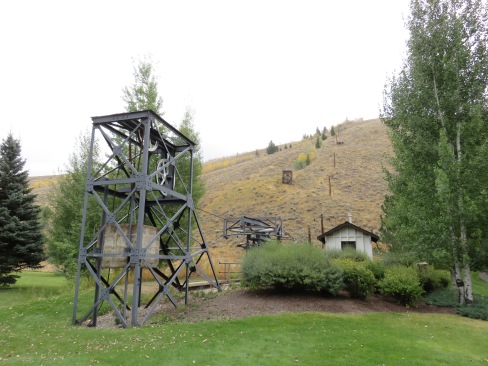
Despite the dominance of European companies in today’s tramway business, the ubiquitous chairlift was actually invented in Nebraska by the most American of corporations. Union Pacific Railroad built the world’s first chairlift at its new Sun Valley Resort in 1936 based on a design by their lead bridge engineer. The two original single chairs were fabricated in the rail yards of Omaha and installed on Dollar and Proctor Mountains in time for the 1936-37 ski season. Dollar’s original lifts are long gone, replaced by ones from Hall and Lift Engineering (and eventually Doppelmayr detachable quads in 2007.)
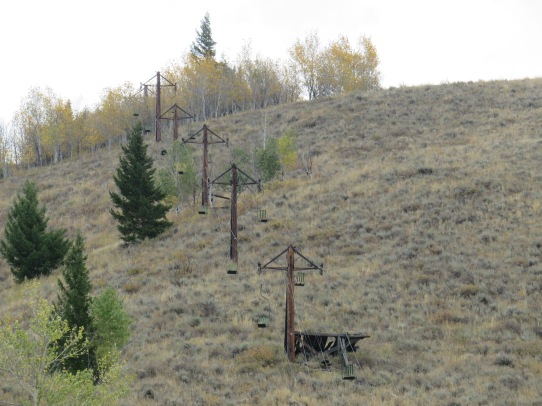
Just down the road from Dollar you can go back in time to Ruud Mountain, where the world’s third chairlift still stands among 10-bedroom mansions and two holes of the Sun Valley Golf Course. The Sun Valley Company has preserved Ruud Mountain pretty much as it was during World War II with its chairlift and ski jump. The top-drive, bottom-tension lift shows just how little the fixed-grip chairlift has changed since it was invented.
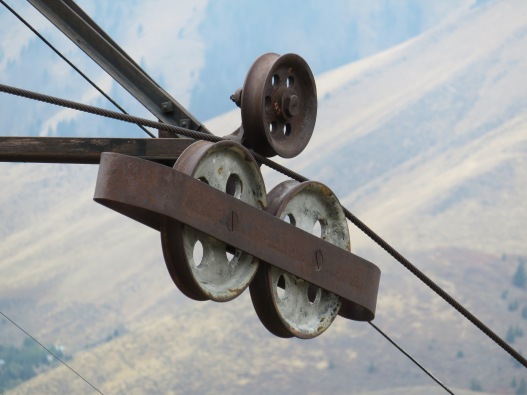
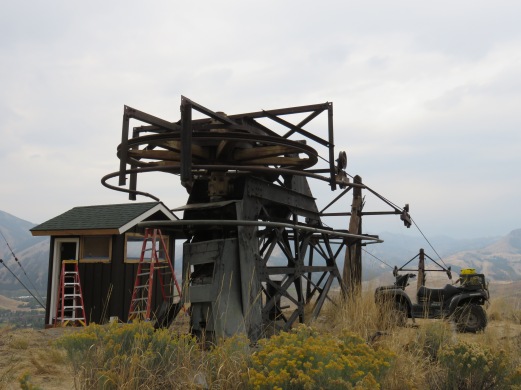
When I visited this week, a crew from Sun Valley Resort was actually building a new lift shack at the top terminal to replace the original which fell down after nearly eighty Idaho winters. Apparently Carol Holding, wife of late Sun Valley owner Earl Holding, wants to preserve the chairlift in as close to its original state as possible. I find it amazing that the lift is still under tension with very few chairs stolen from it (the local nonprofit ski area Rotarun is currently selling the chairs from Sun Valley’s Quarter Dollar lift for $1000 each and they are way less historically significant.)
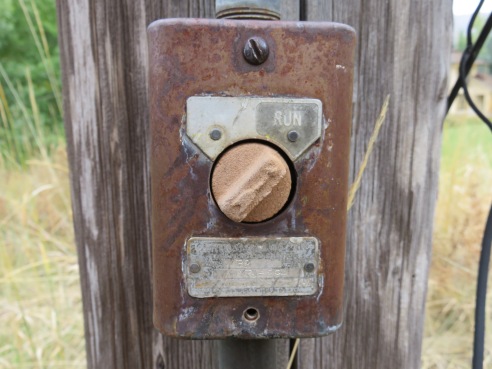
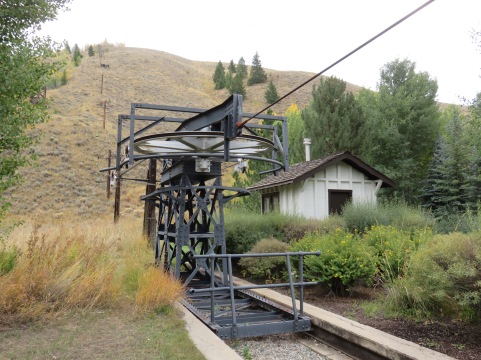
The Ruud Mountain lift isn’t the only one of this generation you can still find standing. Two even run for the public at ski areas in Alaska and Michigan. One of Baldy’s original single chairs lives on at Mt. Eyak and another from Dollar is the Hemlock lift at Boyne Mountain (although it now has Riblet double chairs.) If you’d like to check out Sun Valley’s preserved single chair, just follow Fairway Road from the Sun Valley Resort. You can also access the top terminal from the trailhead at Trail Creek Cabin.
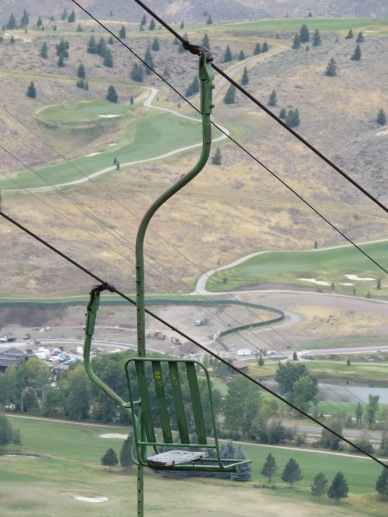

The chair at Boyne Mountain has been rebuilt by Riblet (towers, chairs, sheaves,…) and only the two terminals are left from the original Dollar Mountain chair.
LikeLike
Could they run the lift with nobody on it?
LikeLike
Yes.
The great ski filmmaker Warren Miller rode the tow in the late 1940’s. He commented that it was easy to bounce and get thrown off you didn’t get on very carefully.
LikeLike
We completely rebuilt that lift in 1986. And it could have run. It turned out it would be too expensive to power it up as the power lines had been removed. Generators would have had to be hauled to the top. It was all done for the 50 th anniversary.
LikeLike
The lower foundation of the first chairlift at Proctor Mountain can still be seen. It’s in a field about a mile up on the south branch of the Proctor Mountain trail. Like Ruud, the bullwheel tower ran in a track, tensioned by a counterweight in the stationary tower behind it. This tow was relocated to Baldy ca 1950.
LikeLike
Some old video was just put on youtube of some of the lifts, from 1946. Early in video may be Proctor, later in video may be Bald mountain with steel towers. See https://www.youtube.com/watch?v=-fnj3ICkWLY
LikeLike
Really awesome old footage! Where ever you found it, thanks for bringing it back into view, your YouTube channel is great!
LikeLiked by 1 person
Badger Pass claims “first mechanical lift in the American West” … Who’s right?
LikeLike
To my way of thinking, Sun Valley had the first ‘chairlifts’. Badger Pass had a ‘mechanical lift’ which was actually a cable drawn sled. There is no proof that it was the “first mechanical lift in the West” – I have no documentation but I’m sure the miners during the Gold Rush rigged ‘mechanical lifts’ to transport ore before 1936. My $0.02
LikeLike
I actually just finished a video project this on topic, linked below for those who are interested. Based on the sources I used (second to last slide of video), here are my thoughts on the first “mechanical lift” in the West.
As has already been said, the first chairlifts were built at Sun Valley in 1936 and designed by James Curran. In the early 20th century, primitive surface lifts were created by cannibalizing old mining equipment. The history is difficult to track here, since these were homemade and typically built/torn down quickly. A famous example was the Aspen Mountain “Boat Tow” and although I am unfamiliar with the Badger Pass cable tow, it sounds similar. Aerial lifts at mines were widespread across the American West at the turn of the century for ore transportation. The first ones were built in the 1870’s. The very first aerial lift in North America was a simple gravity powered tram at a mine in Clear Creek County, Colorado built in 1868. The first passenger-specific aerial lift in the West was likely the Sunrise Peak Aerial Cableway at Silver Plume, Colorado.
LikeLiked by 1 person
I just read that the poma lift inventor was the first chair lift inventor in 1934?
LikeLike
I finished a video project about ropeway history a while back (link below if any one is interested), so I here are some thoughts based on the background research I did.
The first chairlifts were definitely James Curran’s single chairs at Dollar and Proctor Mountain in Sun Valley in 1936. Prior to that, ropeways, used for skiing were either rope tows, early J-bars and T-bars, or unique cable tow contraptions that often used old mining equipment. The dates for these early surface lifts can be somewhat contradictory (for example I have read that the first “Poma lift” was installed in either 1934 or 1935 depending on the source). A lot of the surface lift history is clustered around the 1930’s with Poma, Doppelmayr, and Constam (credited as the inventor of the J-bar/T-bar) all tracing their start to this time frame.
Before the early surface lifts, aerial mine trams were common and widespread across the American West. The first passenger ropeways and chairlifts were often composed of former mine tram components, such as Aspen’s original Lift 2 (a unique Heron bicable chairlift) or the very first Collins Lift at Alta.
LikeLiked by 1 person
As has already been said, the first chairlifts were built at Sun Valley in 1936 and designed by James Curran. Before the chairlift, skiers were transported uphill by rope tows, J-bars/T-bars, or primitive cable tows. The history is difficult to track here, since these were homemade (often from old mining equipment) and typically built/torn down quickly. The dates can be somewhat contradictory, for example I have read that the first “Poma lifts” were built in 1934 or 1935 depending on the source. Many of the manufacturers trace their history back to surface lifts in the 1930’s including Poma, Doppelmayr, and Constam (widely credited as the inventor of the J-bar/T-bar). Aerial mine trams were popular and widespread throughout the American West around the turn of the century. Many early surface lifts and chairlifts, like Lift #2 at Aspen (a Heron bicable single chair) and the original Collins at Alta, were built using parts from old mine trams.
Hope that adds some clarity. A little more than you bargained for, but that relates to some other comments on this post as well. I got this information from some background research I did for a video project on Ropeway History. The link is here for reference or if anybody is interested https://youtu.be/AxSBsNbUXyc
LikeLike
What about plumes Eureka peak in plumas county ca ??? I believe they started riding in the ore cars of the Ariel tram and would ski down circa 1850. Great museum in johnsville ca state park with lots of documentation.
LikeLike
Not much mentioned about Von Roll. The 1st detachable monocable ropeway was the legendary Von Roll VR 101.Von Roll was also responsible for bringing the 1st detachable monocable gondola lift to the USA in June 1956. The Disneyland Skyway. Doppelmayr used the license from Von Roll to build most of there detachable monocable lifts using the Von Roll VR 102 grips. As for Jigback trams, Von Roll invented the emergency track rope breaks in 1908 in the Wetterhorn. 1887, Von Roll built the 1st funicular with emergency brakes as well. Doppelmayr bought out the ropeway division of Von Roll in 1996 and to this date, Doppelmayr uses Von Roll technology on there new installations.
LikeLiked by 1 person
here’s some great photos of the Ruud mountains lifts such as the J bar, and the two single chairs. There are some photos of the lifts during construction. https://www.remontees-mecaniques.net/bdd/reportage-tsf1-proctor-mountain-dollar-mountain-ruud-mountain-american-steel-wire-company-7923.html
LikeLike